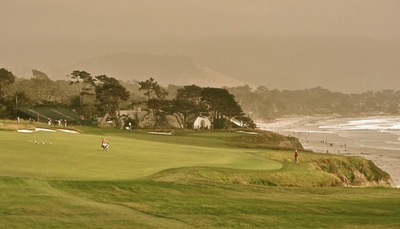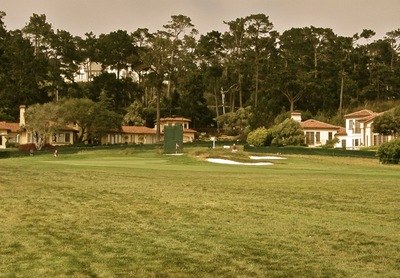Pebble Beach Then And Now: #13
/That's Chandler Egan teeing off No. 13 in 1929, and the modern view below. The green was by MacKenzie, circa 1926. Egan labeled the new fairway bunker "sandy badlands."


When you come to think of it that is the secret of most of the great holes all over the world. They all have some kind of a twist. C.B. MACDONALD

That's Chandler Egan teeing off No. 13 in 1929, and the modern view below. The green was by MacKenzie, circa 1926. Egan labeled the new fairway bunker "sandy badlands."


If my spellbinding Tweets didn't capture the mood of the Tiger Woods pre-U.S. Open press conference, Christine Brennan's piece in today's USA Today should do the job.
Woods was feeling so comfortable he let loose with a few quips Tuesday, although the obsequious press corps laughter that used to accompany his humor has largely dissipated.
You've heard the one about the tee shot he hit on the gorgeous 18th hole 10 years ago, the shot that went into the Pacific?
"I hit it halfway to Japan, yeah," he said.
When asked to choose the sites of the four majors he would love to play in a season, he said, "I'd probably pick St. Andrews all four times."
Tiger was getting into a days-of-yore groove relatively early in the news conference when, out of nowhere, a journalist dared ask a newsworthy and legitimate question.
"On the basis that all our professional lives are affected by our personal lives, can you tell us if you've got any resolution one way or the other with Elin yet?"
"That's none of your business," snapped the man who once willingly posted family pictures on his web-site to sell an image that ultimately was a lie, clearly suppressing every ounce of his new kinder, gentler, Buddhist nature.
Another Chandler Egan green surrounded by dunes (above) and the modern version (below).


Monte Burke of Forbes.com asked me some questions about the blog and this week's U.S. Open, as did Daniel Riley at GQ.com.
For some reason my Tweets aren't appearing today, so here's a feed courtesy of Twitter. Because I know you're just dying to read my play by play of Tiger's press conference.
If this week's weather forecast is any indication, it looks like the Weather Warning signs will get plenty of action there.
Do I need to say anything?

Complaining! Now it's a U.S. Open!
That's Henrik Stenson, as quoted by Doug Ferguson.
Chandler Egan, who I profiled in last week's Golf World, oversaw the creation of the imitation dunes green on top. The modern version is below.


Just one of those great little U.S. Open stories that you don't get anywhere else. Thanks to reader Rob for catching this act of coolness by qualifier Russell Henley.
I walked all 18, but to save you a cart or caddy fee, I'll just stick to some things that stood out.
Overall, the course appears to be in excellent condition with fairly benign rough in most places other than the immediate bunker surrounds, which are extremely severe. Most of the setup touches look excellent, and Jack Nicklaus's 5th hole has aged quite nicely. Thanks to exploding bunker sand and time, it has settled nicely into an old looking hole. Plus, look for the tees to be moved around the 5th to liven things up.
That said, here are a few other observations and images. (You know the drill, click on the image to enlarge.)
The third hole (below) has long been one of my favorites and while I've seen images and aerial flyovers of the new bunkers, to actually get to see this atrocious addition in person was particularly disheartening because it has stripped a wonderful bit of subtlety from the course. Prior to the bunker installation, drives not drawn around the corner would run through the fairway into rough, leaving a hanging flyer lie with OB lurking over the green. Barring a really terrible lie, the fairway bunker shot is now easier to control and the scarier elements for the elite player largely eliminated. Plus, they are woefully out of proportion for the hole and look more like beamed in Bay Hill bunkers than Pebble Beach originals.
Davis Love tees off on the sixth (below), which has been dramatically improved by the decision to move the fairway closer to the ocean. However, the swath of rough leading into Arnold Palmer's poorly-scaled new fairway bunkers leaves a lot to be desired. It'll be interesting to see how players attack this, but I'm guessing that in benign conditions there will be a lot of three woods off the tee, which was probably the desired effect of the new bunkers (you know, to offset today's improved player athleticism and force a longer club into this reachable par-5).
Below is the previously mentioned rough leading into the fairway bunkers. It didn't stop one player from reaching the sand though:
You have to be comfortable with heights to sit at the top of No. 7's huge grandstand (below). But the view is worth it.
The much talked about 10th fairway (below), where the tight mow next to the hazard will be worth watching as predicted. My first impression is that the slippery slope into the rocks will only be a factor if the course gets extremely firm and fast. Either way, it's an amazing hole. Big newsflash there.

The best angle to approach the 11th (below) is unfortunately bathed in rough.

More than the mown-down turf leading into the world's largest water hazard, the tight turf leading into Pebble Beach's fairway bunkers figures to make a difference along with the extreme fescues on the outer edges. Expect to see a meaningful role played by Pebble Beach's bunkering this week.
Stuart Hall looks at some of the key holes and changes to Pebble, and though I'm anxious to see many things, this is the best description of what figures to be a unique situation at No. 10. I should be able to say more about it in a few hours!
In a word, Miller describes the hole as "brutal" and suggests it may be harder than its brethren.
The 10th fairway will have something of an optical illusion. The drive zone will reach 65 to 80 yards in width at various points, the rationale being that the fairway cants so severely to the right that the drive will not play that wide. And because the fairway is snuggled along the cliff line, players must be wary, especially since the best angle into the green is from the right.
"You want to get your ball as close to the ocean as you can because, No. 1, it's flatter down there and, No. 2, you have a much better angle into the green," Davis said. "But then you run the risk off the tee that if you overcook it, you are headed into the ocean."
Geoff Shackelford is a Senior Writer for Golfweek magazine, a weekly contributor to Golf Channel's Morning


Copyright © 2022, Geoff Shackelford. All rights reserved.